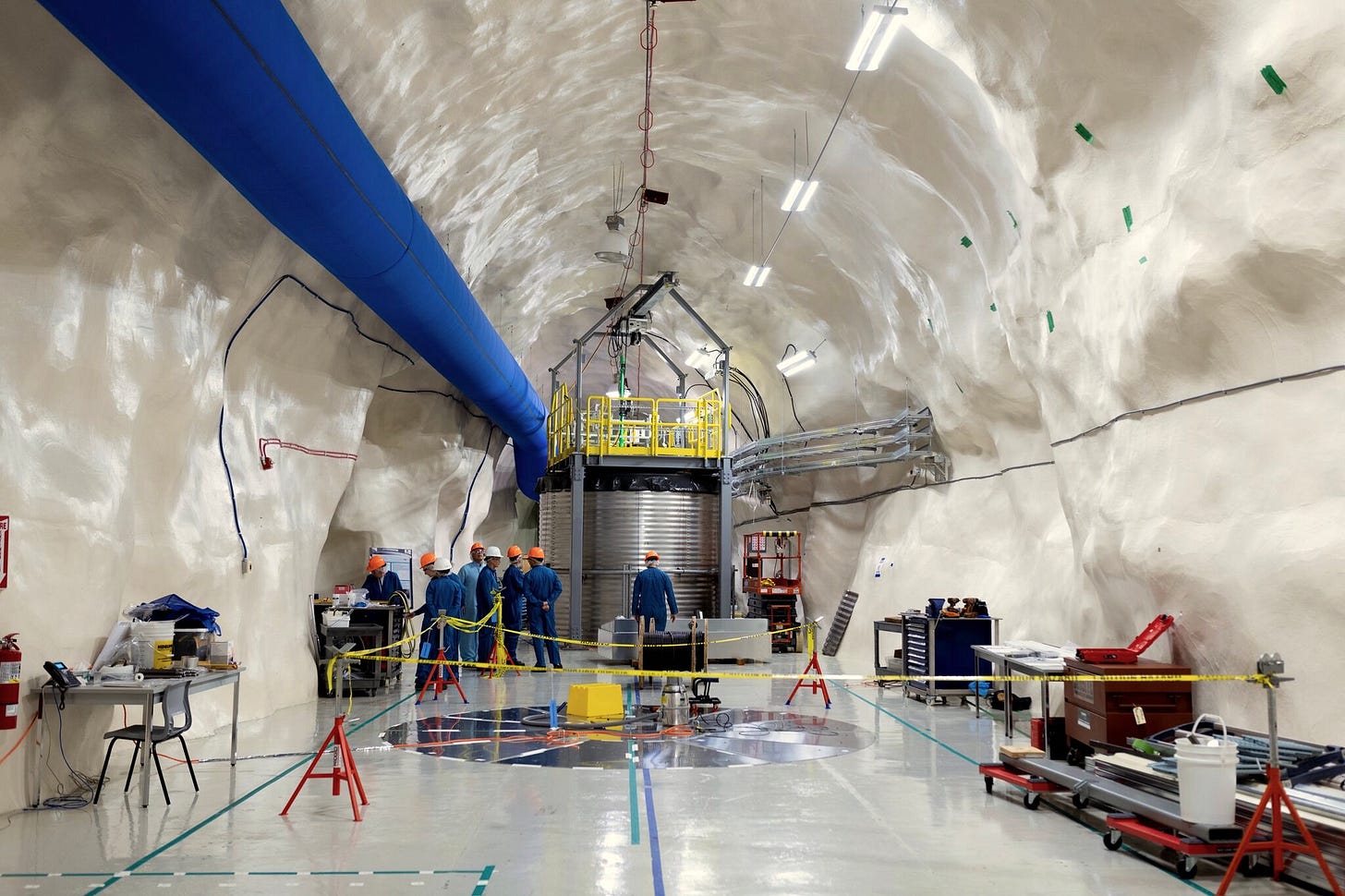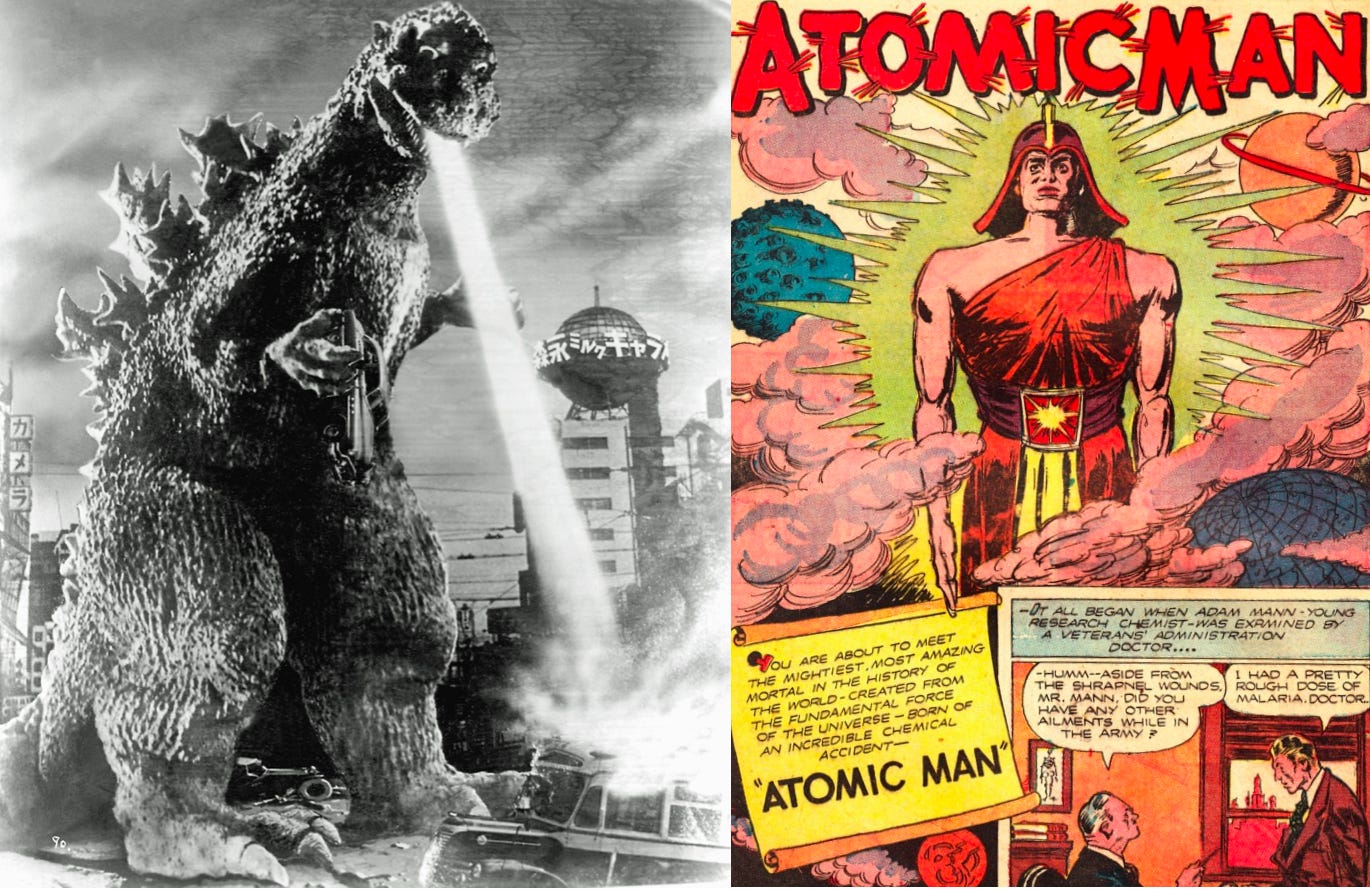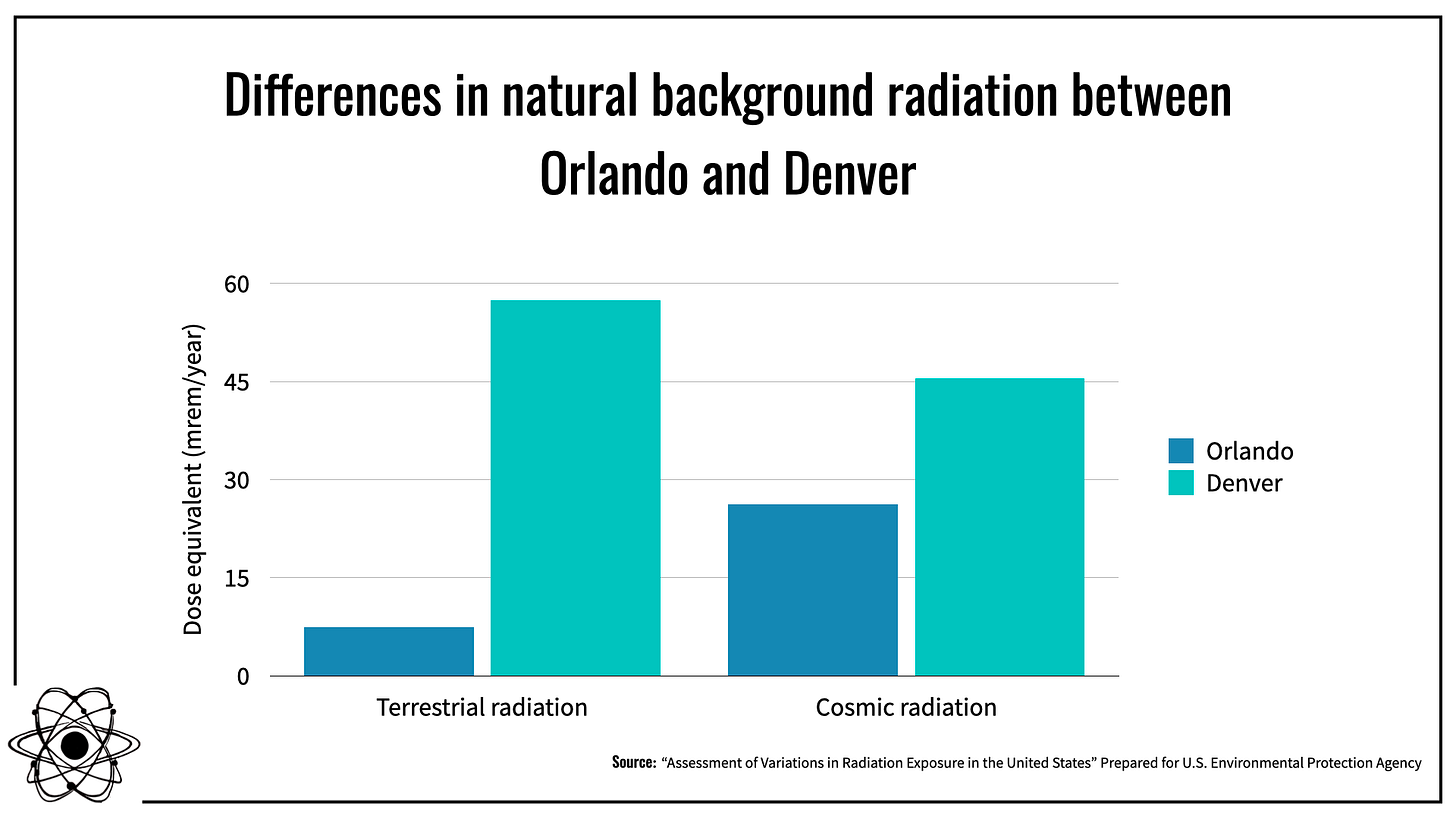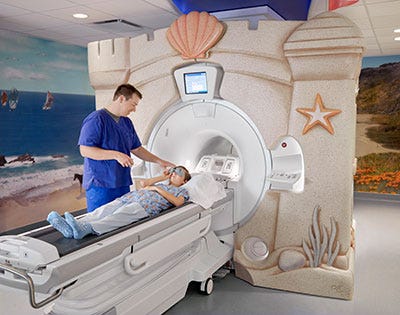Dose of Reality: A Primer on the Health Impacts of Ionizing Radiation
There’s perhaps no plot device more powerful and crucial in science-fiction than radiation. It can awaken a prehistoric sea creature and give it atomic halitosis. It can turn a nerdy teenager into a wall-crawling, web-slinging crime fighter. It can super-size ants, spiders, turtles, or shrink a man down to the microbial world. The mythology is paradoxical: radiation can empower and fortify to create superior beings, and it can damage and distort into nightmarish abominations.
Our understanding of radiation is also paradoxical.
We think about radiation in terms of acute exposure, something we can somehow encounter if not careful or if absolutely necessary. In reality, we’re completely awash in radiation at all times.
We think of radiation as unnatural, the result of scientific tampering or an experimental new technology. In reality, much of the radiation we’re exposed to is natural.
We think of radiation as mysterious: an odorless, tasteless, invisible force. Yet we know more about the sources and effects of exposure to ionizing radiation than to almost any other hazardous agent.
If this is true – if we know so much about radiation – what are the real risks of radiation? Is it as dangerous as we tend to think? How much is too much? Can radiation be beneficial? The answer to these questions gets to the heart of the debate over nuclear energy today. To answer them, we'll need to cover:
The most commonly-used model of health risks from exposure to low levels of ionizing radiation (and why it’s so controversial)
How radiation affects DNA and what our bodies can do about it
The results from natural experiments in long-term radiation exposure
The danger in our current understanding of radiation risk
Let’s dive in.
Introducing Linear No-Threshold
Almost all regulations and analyses of risk or harm from radiation are based on the “Linear No-Threshold” (LNT) model. We can understand the basics of the model by breaking down the phrase:
“Linear” is meant to convey that cell damage, and thus health risk, increases linearly with the dose of radiation received. Based on harm observed at high doses of radiation, harm from low doses can be extrapolated by extending the “dose versus risk” line back to infinitely small doses.
“No-Threshold” indicates there is no safe amount of radiation. Any amount of ionizing radiation carries some risk of harmful effects, no matter how small.
Under the basic LNT model, radiation dose is counted by taking the total accumulated dose over time. The dose rate — how rapidly you are exposed to an amount of radiation — is irrelevant.
This last point is the one that LNT opponents hone in on to demonstrate the absurdity of the risk model. Based on the assumptions outlined above, LNT says absorbing 5000 mSv in an hour is the same as receiving 5000 mSv evenly spread out over 50 years. Opponents analogize this to saying one shot of whiskey in your coffee every morning for a year poses the same amount of risk as taking 365 shots of whiskey in a single morning.
There’s a similar implication at the population level. LNT says 5,000 people receiving 1 mSv is the same as 1 person receiving 5,000 mSv. Sticking with the drinking analogy, this would imply 200 people drinking 1 glass of champagne at a wedding has the same cumulative health impact as the bride drinking 200 glasses herself.
But these analogies mischaracterize the position of today’s users and defenders of Linear No-Threshold.
For short-term effects, they would argue that there is a clear threshold – acute radiation syndrome (ARS). In the drinking analogy, this would be the equivalent of alcohol poisoning. This threshold is pretty easy to identify and requires extremely high doses compared to most of the exposures humans may have. But that’s not what LNT is attempting to model.
What LNT is estimating are the potential health risks associated with low levels of ionizing radiation. Namely, we’re interested in knowing how exposure to small amounts of radiation increases the risk of developing cancer. Biophysics suggests a higher dose rate would be more likely to cause cancer. Let’s examine why this is by looking at the source code in our cells – DNA.
Radiation and DNA
Non-ionizing radiation doesn’t have enough energy to directly affect the structure of atoms or damage DNA. Discussions about the health risk of radiation are concerned with ionizing radiation. This type of radiation acts like a little cannon shot that can break DNA strands. There are three principal types of ionizing radiation: alpha particles, beta particles, and gamma rays.
Think of an alpha particle as a big cannon ball. Alpha particles are heavy and large, making them slow but powerful. They can do significant DNA and cell damage inside the body, but lack the energy to penetrate the skin. So, it is far less likely to get alpha particles inside your body; but if you inhale or swallow radioactive material that emits alpha particles, it can be quite harmful.
Beta particles have the opposite characteristics. They’re high energy and thus fast-moving, but 1/8000th of the size of an alpha particle. That makes them more penetrating, but due to their teeny tiny size, far less likely to hit anything other than empty space. And still, they can be blocked by clothing or something like aluminum foil.
Gamma rays are less like cannons and more like ray guns. Unlike alpha and beta particles, which have both energy and mass, gamma rays are pure energy. As such, they are much more difficult to obstruct. Several inches of lead or a few feet of concrete would be required to stop them.
It’s important to note that radiation isn’t the only thing that causes DNA breaks. Other exposures like chemical carcinogens can cause these breaks. Simply having a metabolism (i.e. being alive) also leads to DNA breaks and damage. DNA is always breaking — that’s just a part of life.
Fortunately, our cells have mechanisms for repairing strands. Single-strand breaks are common and relatively easy to repair. Double-strand breaks are more difficult because the code can’t be read from the other side. Your body can repair double-strand breaks, but it’s much harder, involving more steps and thus possibility for error.
A higher dose rate of radiation means there’s greater potential to cause more double-strand breaks that can overwhelm or escape repair mechanisms. This can lead to “bad code”, increasing the chance of cancer development.
Radiation Risk and Rolling Dice
Obviously any attempt at reducing something as complex as the effects of ionizing radiation on human health is fraught right from the get go. But here’s my attempt at a better analogy for radiation risk: rolling dice.
Each die has a lot of sides, let’s go with 20. And let’s say that rolling snake eyes, or two “1”s, represent a double strand break. Again, the more double strand breaks, the greater the risk of developing cancer.
It’s possible to get snake eyes on the very first roll with only two dice – that’s just really bad luck. But you’re much more likely to get double 1s when you are rolling more than two dice at a time. AND the more times you roll, the more likely those snake eyes will show up. So higher doses (throwing more dice at once) and greater exposure (rolling more frequently) leads to increased risk of double strand breaks (getting snake eyes) and thus developing cancer.
Under the most simplistic model, LNT implies you should expect to get the same number of snake eyes rolling two dice 100 times as rolling 20 dice 10 times. Probabilistically, that math doesn't check out – the second strategy is about 10x as likely to result in snake eyes. This gets back to one of the main critiques of LNT: by ignoring dose rate, the model does not adequately take into account the body's ability to repair DNA damage.
However, many users of LNT now include a “Dose and dose rate effectiveness factor” (DDREF). This modifies the model to take dose rate, and the body’s response mechanisms, into account. The result is a more accurate portrayal of chronic or low doses as less likely to cause cancer than acute or higher doses.
LNT isn’t perfect, but no model is. Regardless of their complexity or the level of detail they attempt to capture, all models are ultimately wrong. What’s more, the problem of modeling the long-term health impacts of low doses of radiation is particularly wicked.
First, it’s hard to get reliable data. We are awash in low-level radiation day in and day out – it would be impossible to determine the exact dose from each of the sources. Also, we don’t get to see the results of each dose or “roll” – we only find out about cancer later in life, with no idea which particular exposure led to it. On top of that, lots of things other than radiation cause cancer. In fact, cancer is the leading cause of death in most wealthy countries. This makes sense – if you’re living in a richer, safer society, you’re more likely to live long enough to experience cancer.
But perhaps with a large enough population exposed to extra radiation and a long enough observation period, maybe we could have enough data to detect the effects?
Turns out we do have this data due to naturally occurring radiation hot spots around the world.
Natural Experiments in Radiation
People across the world are exposed to wildly varying levels of background radiation.
Those who live at higher elevation have less atmosphere to block cosmic radiation, resulting in greater exposure. Some places have higher background radiation due to the concentration of uranium or thorium in the soil and rock. Radon (a naturally-occurring radioactive gas) also varies geographically and can accumulate indoors.
For example, a person in Denver is exposed to about 8 times as much radiation from the ground and 2 times as much cosmic radiation as someone living in Orlando
In fact, there are places on earth with significantly greater levels of background radiation than Denver. Despite some very determined searching, we haven’t found any evidence of increased cancer due to the elevated levels of radiation in these places.
A study conducted in China from 1987-1995 observed more than 100,000 people in two groups. The first group lived in Yangjiang, with an average exposure 3 times higher than that of the control group in a neighboring city. That’s because the sand in Yangjiang is rich with thorium, which is weakly radioactive. Here were the results of the study:
“We did not observe an increase in cancer in the HBRA [high background radiation area]...We did not find any increased cancer risk associated with the high levels of natural radiation in HBRA. On the contrary the mortality of all cancers in HBRA was generally lower than that in the control area, but not statistically significant.”
Ramsar, Iran, is a town on the sea with the highest measured natural background radiation levels in the world – higher than the Chernobyl exclusion zone. In a study of lung cancer rates within Ramsar’s health districts, the highest mortality rate was found in a district called where the radon levels were normal. Interestingly, the lowest lung cancer rates were found in a district where the radon levels are 19 times higher than the EPA limit for remedial action (I’ll leave “radon mitigation is a racket” for a different article). Granted, the sample size of this study was small. But is there a reason this could possibly be?
Direct evidence is spotty for the same reason it’s been hard for us to answer the LNT question: the doses, and thus the health impacts, are so tiny that they are difficult or impossible to detect. But there is a hypothesis that radiation at low doses is actually beneficial.
Radiation Hormesis
Hormesis is the idea that exposure to something damaging can actually be beneficial for our health. Think exercise, fasting, vaccination. We intentionally stress our cells and muscles up to the point of mild injury. Then our body repairs this damage – plus a bit extra.
There's speculative evidence that radiation exposure plays an important biological role, helping with our genetic repair and replication systems. Experiments where cells or organisms were completely shielded from radiation led to impaired cell growth and reduced repair response.
This work is being continued at SNOLAB, a facility in Canada located 2 kilometers underground. The REPAIR team is designing experiments to look at cancer risk in human cells and the ability to repair DNA damage in the absence of cosmic, terrestrial, and man-made radiation.

Will our DNA repair system work like other systems in the human body? If so, exposure can be thought of like weight lifting. Lifting way too much weight can kill you. Lifting slightly less than that but still too much can still overwhelm the body’s repair mechanisms, which can result in injury. Lifting the right amount of weight leads to healthy muscles and maximum gains. And doing no weight training or exercising means you’ll have weak muscles and reduced health.
Sure enough, there's a long tradition in human history of visiting thermal springs or beaches with spicy sands (black monazite) for healing and revitalization. Even nuclear-fearing Germans and Austrians continue to flock to spas offering radon treatments and baths.
Research vs. the Real World
Many of the fiercest opponents of LNT come from the pro-nuclear community. It’s not too difficult to understand why. LNT has been used to stoke fears about radiation, fuel regulatory ratcheting, and perhaps most egregiously, prematurely shutdown existing carbon-free nuclear plants.
Nuclear advocates will point to hormesis evidence, cite studies that offer results inconsistent with LNT estimates, show how different models offer more explanatory power, and so on. The result is a battle between two extreme views: LNT diehards who believe radiation is uniquely dangerous and there’s no safe exposure, and LNT truthers who believe debunking the model will magically change the way society sees nuclear. These positions are two sides of the same coin: one anti-nuclear, one pro-nuclear, but both assert that the risk profile at incredibly low doses is A) attainable and B) is of extreme importance.
This battle disguises an important distinction between research and the real world. Scientists and other radiation experts looking at this problem have an incredibly narrow focus: how do low doses of radiation affect long-term health outcomes? If a single alpha particle is almost guaranteed to cause a double strand break, then it is possible that a single exposure can lead to cancer down the road. In this sense, “no threshold” is technically correct; there is no amount of radiation that doesn’t present some risk, even though it may be incredibly small.
Policymaking, however, is of an entirely different nature. Good policy cannot afford to take a narrow focus. It requires the consideration of many factors, a careful weighing of the many risks and rewards of any decision. This is not the place for “technically true” because by definition, it means there’s limited or incomplete representation of the full picture or context.
It’s technically true that there’s no safe level of driving. But governments aren’t banning cars and ripping up highways. Parents continue to drive their kids to school everyday. Trucks continue to deliver the goods we need and enjoy. Benzene, arsenic, and formaldehyde are all carcinogenic chemicals, yet we continue to use them in our fuels, fertilizers, plastics, and preservatives because we recognize the massive benefits to society.
The problem is that an absolutist “no safe exposure” framework has been selectively applied to nuclear power. By obsessing about quantifying risk at extremely small doses of radiation and failing to take into account the benefits of radiation source or other dangers, LNT has become a misuse of the precautionary principle.
However, we already know that radiation risk can be properly evaluated and managed: it’s done every day in hospitals and doctors’ offices around the world. The low doses discussed here are less than or equal to exposure from CT scans, X-rays, PET scans, fluoroscopic exams, and mammograms. But even much higher doses can be better than not getting radiation in the case of treatments for tumors or cancer.
These tests and therapies improve health outcomes and increase life expectancy. What this tells us is that in medicine at least, doctors are able to balance the health risks of radiation with the benefits of the tests or treatments they’re administering.
When it comes to nuclear power, regulators and lawmakers have been completely unable or unwilling to weigh the extremely small risks (meaning if or when a release of radiation occurs) against the unusually rich rewards.
The Danger in “No Safe Exposure”
The idea that there is no safe amount of radiation has been far more harmful to human health than any radiation exposure from nuclear power.
"No safe exposure" turned Fukushima Daiichi from an accident into a disaster. The Japanese government panicked based on dose rates that were 1-10% of the natural radiation of Ramsar, Iran. Authorities decided to hurriedly evacuate Fukushima prefecture in the midst of the natural disaster. Hospitals were moving people on life support or in critical condition, leading to immediate deaths. Nursing homes were moving their residents, which nearly tripled the increased risk of death among the elderly. In total an estimated 1,600 deaths are attributed to relocation in the first 3 years after the accident. In contrast, there were zero deaths or injuries from the nuclear accident, aside from two workers who were killed by the tsunami while conducting emergency repairs immediately after the quake.
The idea that there is “no safe exposure” caused immense human suffering in the aftermath of Chernobyl. I’ve outlined many of the consequences in my thread about the accident.
There is no evidence of heritable effects of radiation from Chernobyl. There’s not even evidence of heritable effects of radiation from atomic bomb survivors – and that was a sudden extreme dose. That hasn't stopped groups from attributing a range of heart conditions – collectively dubbed Chernobyl Heart – in children from Belarus and Ukraine to the accident decades later. It’s great that children are getting medical attention, but it has absolutely nothing to do with Chernobyl radiation. These organizations keep alive the mythology of heritable diseases and deformities from radiation.
“No safe exposure” has been used to prevent nuclear from being built and to justify shutting down high-performance nuclear plants in their prime.
“No safe exposure” has been used by anti-energy activists to deny affordable, clean, life-giving power around the world.
In a world full of risks, we have massively over-weighted radiation in an ultimately harmful manner.
Putting Radiation Risk Into Context
Rather than demanding zero radiation risk, it must instead be put into proper context.
The consequences for the most exposed group of atomic bomb survivors was an average loss of life expectancy significantly lower than that caused by severe obesity or smoking.
Even under the LNT model of risk, simply living in a city like London or New York increases your risk of mortality 3-7 times as much as the radiation received by Chernobyl liquidators.
This reveals an important truth about LNT: the problem was never the model. The problem was the weaponization of the model: citing the risk of radiation without comparing it to other risks we face or comparing it to the risks of the alternatives.
If you exposed a group of 100 Americans to 100 mSv of radiation, one would be predicted to get cancer as a result (for context, the people who lived in the Fukushima prefecture will receive around 10 mSv over their entire lifetime). But 42 of those people would be likely to get cancer from other causes. “I’d be a damn sight more worried about the 42, especially when that one case could mean we make other mistakes in determining where our energy should come from,” says Professor Geraldine Thomas, a molecular pathologist and Director of the Chernobyl Tissue Bank.
With the proper context, LNT can and should be used to justify a massive build out of nuclear power plants around the country. The calculated risks are incredibly small and are massively outweighed by the risks nuclear plants displace. Risks like:
Air pollution from fossil fuel usage
Climate change from greenhouse gas emissions
Energy vulnerability from reliance on imported fossil fuels
Energy scarcity from lack of generation or resources
Takeaways
Radiation is not uniquely dangerous. Radiation risk is not necessarily more or less significant than other types of risks, it should be considered and managed in the context of the range of potential risks and hazards we face.
Our bodies are well-equipped to handle radiation. It may even be the case that low levels of radiation is good for our bodies, promoting healthy cellular function and genomic stability.
Low doses pose low risk. Even under a conservative risk model like LNT, the health risks posed by low levels are incredibly small and inconsequential in comparison to other health risks we are faced with everyday.




















